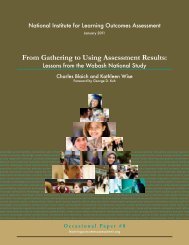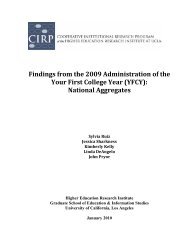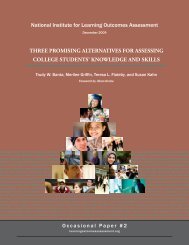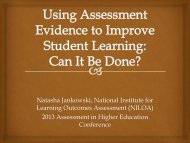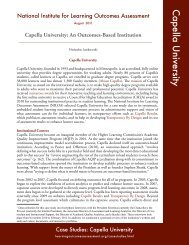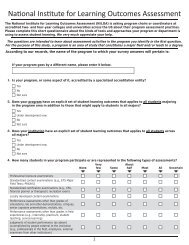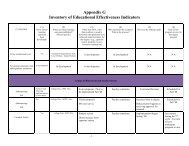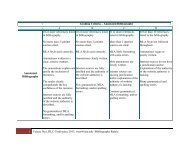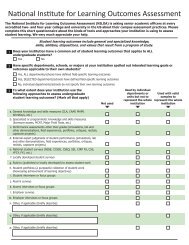Opening Doors to Faculty Involvement in Assessment - National ...
Opening Doors to Faculty Involvement in Assessment - National ...
Opening Doors to Faculty Involvement in Assessment - National ...
You also want an ePaper? Increase the reach of your titles
YUMPU automatically turns print PDFs into web optimized ePapers that Google loves.
Foreword (cont<strong>in</strong>ued)<br />
assessment than their “Boomer generation” colleagues. This may be because they are more<br />
collectivist and team oriented—erod<strong>in</strong>g the “isolation <strong>in</strong> the classroom” syndrome that Pat<br />
so accurately describes. But wherever it comes from, it is bound <strong>to</strong> be good for assessment’s<br />
future.<br />
The meat of Pat’s paper is offered <strong>in</strong> six recommendations for “open<strong>in</strong>g doors <strong>to</strong> faculty <strong>in</strong>volvement<br />
<strong>in</strong> assessment.” The first—embedd<strong>in</strong>g assessment directly <strong>in</strong><strong>to</strong> the regular curriculum<br />
through mapped and targeted assignments, graded validly and reliably through carefully<br />
designed and piloted rubrics—has always been a personal favorite of m<strong>in</strong>e, and I argued for it<br />
<strong>in</strong> my Occasional Paper a year ago. The second and third—more emphasis on faculty development<br />
offered through campus Teach<strong>in</strong>g and Learn<strong>in</strong>g Centers, and greater emphasis on <strong>in</strong>structional<br />
tra<strong>in</strong><strong>in</strong>g (and assessment) <strong>in</strong> prepar<strong>in</strong>g future faculty <strong>in</strong> graduate tra<strong>in</strong><strong>in</strong>g—are familiar,<br />
though this by no means dim<strong>in</strong>ishes their appropriateness. The fourth—mak<strong>in</strong>g assessment<br />
technique and evidence an <strong>in</strong>tegral part of the Scholarship of Teach<strong>in</strong>g and Learn<strong>in</strong>g—reflects<br />
Pat’s own successful his<strong>to</strong>ry of do<strong>in</strong>g this over many years at the Carnegie Foundation for the<br />
Advancement of Teach<strong>in</strong>g and as AAHE’s found<strong>in</strong>g <strong>Assessment</strong> Forum Direc<strong>to</strong>r.<br />
The last two recommendations, though, are not only sound but are fresh as well. The fifth<br />
cogently notes the fact that colleges and universities lack spaces and opportunities for faculty<br />
<strong>to</strong> discuss and make mean<strong>in</strong>g of assessment results through susta<strong>in</strong>ed engagement. Time<br />
constra<strong>in</strong>ed committee discussions are no place for serious collective reflection and there is<br />
simply no “room” for this activity (figuratively or literally) <strong>in</strong> current campus discourse. This<br />
is a serious limitation and it ought <strong>to</strong> be addressed. Sixth, Pat urges us <strong>to</strong> <strong>in</strong>volve students<br />
directly <strong>in</strong> assessment. Now there’s an idea! Not only do students have the greatest stake <strong>in</strong><br />
improv<strong>in</strong>g teach<strong>in</strong>g and learn<strong>in</strong>g, they also are closer <strong>to</strong> the data than we are. This means that<br />
they can frequently offer much better <strong>in</strong>terpretations of assessment results and I have seen more<br />
than one campus assessment committee learn this <strong>to</strong> its members’ benefit.<br />
In short, Pat’s paper effectively synthesizes her dozens of years of experience as a faculty<br />
member, consultant, and colleague. To her admirable observations and recommendations<br />
about engag<strong>in</strong>g faculty <strong>in</strong> assessment, I would only add one: remember that you don’t need<br />
everybody on board <strong>to</strong> move forward.<br />
Peter T. Ewell<br />
Vice-President, <strong>National</strong> Center for Higher Education Management Systems (NCHEMS)<br />
Senior Scholar, NILOA



